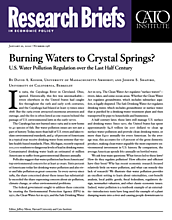The Cuyahoga has not burned since 1969 and is now home to 40 species of fish. But water pollution issues are not just a part of history. Today, more than half of U.S. rivers and lakes violate environmental standards, and 4–28 percent of Americans in a typical year receive drinking water from systems that violate health-based standards. Flint, Michigan, recently exposed 100,000 residents to dangerous levels of lead in drinking water. Contaminated drinking water leads an estimated 16 million Americans to suffer from gastrointestinal illnesses annually.
Polls also suggest that water pollution has been Americans’ top environmental concern for at least 30 years. Sixty percent of Americans today list drinking-water pollution and also river and lake pollution as great concerns. In every survey since 1989, the share concerned about these issues has substantially exceeded the share expressing concern about air pollution, climate change, or other environmental problems.
The federal government sought to address these concerns by creating the Environmental Protection Agency (EPA) in 1970, the Clean Water Act in 1972, and the Safe Drinking Water Act in 1974. The Clean Water Act regulates “surface waters” — rivers, lakes, and some ocean areas. Whether the Clean Water Act regulates groundwater, which includes subsurface aquifers, is legally disputed. The Safe Drinking Water Act regulates drinking water, which includes groundwater or surface water that is purified by a drinking-water treatment plant and then transported by pipe to households and businesses.
A half century later, these laws still manage U.S. surface and drinking water. Since 1970, the United States has spent approximately $4.8 trillion (in 2017 dollars) to clean up surface-water pollution and provide clean drinking water, or more than $400 annually for every American. In the average year, this accounts for 0.8 percent of the gross domestic product, making clean water arguably the most expensive environmental investment in U.S. history. By comparison, the average American spends $60 annually on bottled water.
We ask four main questions: What forces led to these laws? How do they regulate pollution? How effective and efficient have they been? Why has recent economic research focused relatively little on water pollution, and what can remedy this lack of research? We illustrate that water pollution provides an excellent setting to learn about externalities, cost-benefit analysis, local public goods, fiscal federalism, regulatory design, nonmarket valuation, and other classic economic issues. Indeed, water pollution is a textbook example of an externality — introductory texts have long used the example of a plant dumping waste into a river and causing people downstream to suffer to illustrate the concept of externalities.
We emphasize several main conclusions. Many measures of drinking- and surface-water pollution have fallen since the EPA’s founding, due at least in part to the Clean Water Act and Safe Drinking Water Act. The progress, however, is incomplete. William Ruckelshaus, first head of the EPA, noted, “Even if all of our waters are not swimmable or fishable, at least they are not flammable.”
But while these large investments in drinking water do appear to create substantial health benefits, existing evidence suggests that estimated costs of most investments in cleaning up rivers, lakes, and oceans exceed their measured benefits. A summary of cost-benefit analyses of 240 regulations implemented by the federal government between 1992 and 2017 finds that out of five categories of regulations (surface water, drinking water, air pollution, greenhouse gases, and all other regulations, including nonenvironmental ones), surface-water regulations are the only category where total estimated costs exceed total estimated benefits. Estimated total benefits are only 80 percent of estimated total costs, and the mean regulation has benefits that are only 57 percent of its costs. Sixty-seven percent of surface-water regulations fail a cost-benefit test, compared to 20 percent of drinking-water regulations and 8 percent of air pollution regulations.
It is noted that many of these estimates have difficulty quantifying several important channels of benefits and may be understating true benefits. But even if costs are underestimated, there are several reasons regulation of surface-water quality could produce smaller net benefits than other types of environmental investments. For example, surface-water policy does not typically use market-based instruments, such as cap-and-trade markets or pollution taxes, which are generally cost effective. Beyond specific policy choices, surface waters may be more substitutable than other environmental goods — changing the river where a person goes fishing or boating may be less costly than changing the air a person breathes or the water a person drinks.
Unfortunately, economic research on water pollution and its regulation has been limited. An important task for research is to assess which investments in surface-water pollution create net benefits and ways to make these investments more effective.
NOTE:
This research brief is based on David A. Keiser and Joseph S. Shapiro, “U.S. Water Pollution Regulation over the Last Half Century: Burning Waters to Crystal Springs?,” Journal of Economic Perspectives 33, no. 4 (2019): 51–75, https://www.aeaweb.org/articles?id=10.1257/jep.33.4.51.

